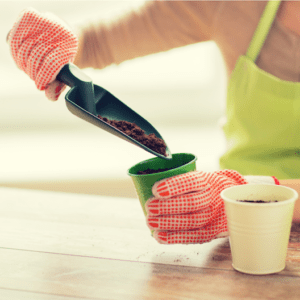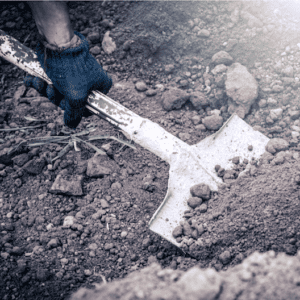Offseason Garden Tool Audit: How to Choose the Right Tools for Your Garden
Congratulations, you made it through another year of gardening! We hope you enjoyed beautiful blooms, bountiful harvests, and the satisfaction that you created something beautiful at your home. As the growing season comes to a close, one area of your garden that you can still work on is your tools. If you’re one of the very few gardeners that use their hands and nothing else, you can stop reading here. For the rest of us, the tools we use in our garden are akin to the brushes a painter uses to create a masterpiece, or the chisel and hammer a sculptor uses to bring the beauty of out a block of stone.
While we, as gardeners, rely quit a bit on nature to do much of the work, it’s important that we are using the right tools that fit each individual’s size, age, and abilities. For example, a short woman using a long handled spade shovel is going to be at risk of injuring their shoulders or back. Garden tools should be comfortable to use, and ergonomically friendly to your abilities. Tools that are damaged, or made if inferior materials can also pose a risk to causing injury to the gardener, along with making a task that should be simple, much more difficult.
Run through this checklist as your wrapping up things in the garden for the year, and keep an eye out at your local garden centers or big box home improvement stores for deals on new garden tools during the winter months!
Garden Size Should Determine Tiller Type
Tilling your garden is an important step in preparing the soil for planting. It helps loosen the soil, which encourages deeper root growth, as well as aids in drainage by allowing water to flow deeper into the garden bed instead of pooling up onto of compacted soil. For most home gardens, a hand tiller is the tool of choice for this job. Most hand tillers have a series of spinning spikes on the end of the handle and work well for softer soil and small garden plots. For harder soil, an axe-style tiller is more effective for breaking through the firm ground. Tilling soil manually can be physically demanding, especially for those with back pain. Depending on physical ability, as well as the size of the garden plot that needs to be tilled, investing in an electric or gas-powered tiller can be a huge time saver, as well as saving you a trip to the doctor!
The Most Used Tool In Your Garden, the Hand Trowel
While the hand trowel is tiny compared to other shovels, it has proven itself for years and years  to be one of the most necessary garden tools. Used to plant flowers, bulbs, small bushes, and more in just about every medium, including flower beds, planter boxes, flower pots, and window boxes, the hand trowel’s smaller shovel head allows you to only remove the soil needed to plant, without disrupting nearby plants. An important feature to consider in your hand trowel, which goes for all hand tools used in the garden, is that the grip is ergonomically friendly. Spend time browsing your local garden center and holding different trowels. You may find that the wood-handle style that you’ve been using for years is much less comfortable than one with a synthetic rubber padded handle.
to be one of the most necessary garden tools. Used to plant flowers, bulbs, small bushes, and more in just about every medium, including flower beds, planter boxes, flower pots, and window boxes, the hand trowel’s smaller shovel head allows you to only remove the soil needed to plant, without disrupting nearby plants. An important feature to consider in your hand trowel, which goes for all hand tools used in the garden, is that the grip is ergonomically friendly. Spend time browsing your local garden center and holding different trowels. You may find that the wood-handle style that you’ve been using for years is much less comfortable than one with a synthetic rubber padded handle.
Not All Watering Cans Are Created Equal
Sure, we all dream of having intricate irrigation systems that deliver the perfect amount of water to each and every plant around our home. Unfortunately for most of us, that dream irrigation system just isn’t in the cards. There’s nothing wrong with using a watering can throughout your garden, as long as you’re conscious of how much to water different kinds of plants. Having 2-3 different sized and style watering cans is the most effective way to hand water your home garden. Lugging around one massive can with 4-5 gallons of water can cause serious strain on elbows and shoulders, and is not recommended. Find smaller capacity cans with spouts that make sense to where you are using them; i.e.-a longer spout is perfect for hanging baskets. While plastic cans are often much lighter than their steel counterparts, leaving them out in the sun can cause the plastic to become brittle and crack over time.
Don’t Just Call a Spade, a Spade
The workhorse of gardens across the planet, the spade is used for digging medium to large holes for planting trees, larger flowers, shrubs, and other large plants that require a large or deep hole for planting. Any garden center or big box home improvement store will most likely carry a vast selection of spades, ranging in length, weight, head size, and handle material. Consider how much digging you do each planting season, and the type of soil that you’re digging in before making a selection. A shorter spade shovel is good for light digging, or while digging in tight spaces like in the middle of a garden, or inside of a greenhouse, but is not good for digging large holes or moving heavy soil. The handle material also plays an important role in choosing the right spade, as a wooden handle may feel study, but prove to be too heavy and not durable over seasons of use. Be sure whichever type of spade you select has a pronounced “stepping edge” on the top of the shovel head so you can use your body weight to help drive the spade into the soil before pulling down on the handle to loosen the area you are digging.
for planting. Any garden center or big box home improvement store will most likely carry a vast selection of spades, ranging in length, weight, head size, and handle material. Consider how much digging you do each planting season, and the type of soil that you’re digging in before making a selection. A shorter spade shovel is good for light digging, or while digging in tight spaces like in the middle of a garden, or inside of a greenhouse, but is not good for digging large holes or moving heavy soil. The handle material also plays an important role in choosing the right spade, as a wooden handle may feel study, but prove to be too heavy and not durable over seasons of use. Be sure whichever type of spade you select has a pronounced “stepping edge” on the top of the shovel head so you can use your body weight to help drive the spade into the soil before pulling down on the handle to loosen the area you are digging.
These tools are just a few of the most commonly used throughout the gardening community. Check back in next month as we highlight some other garden tools that you should take some time to look over this “offseason” and consider upgrading. What are you most commonly used tools that you can’t tend to your garden without? Let us know in the comments and we’ll work them in to the next blog post on this topic!